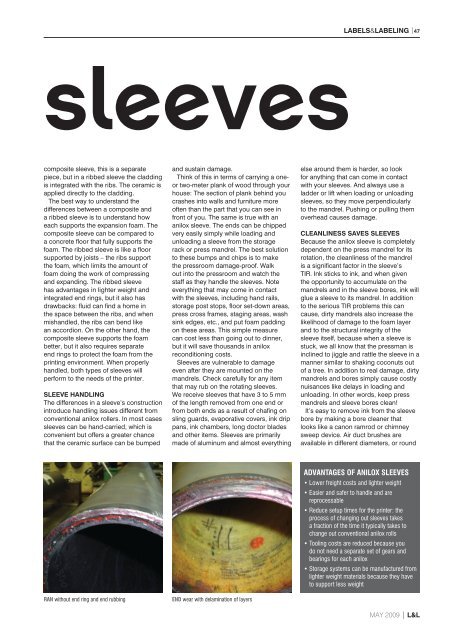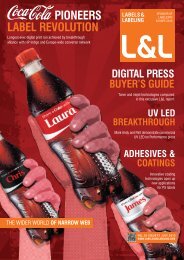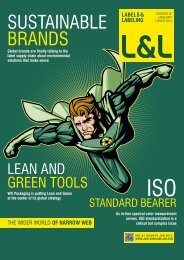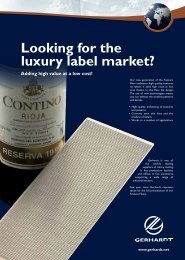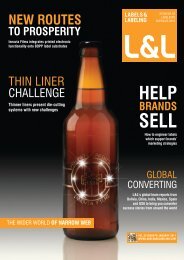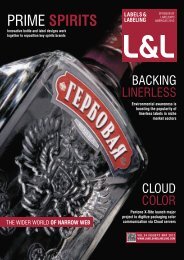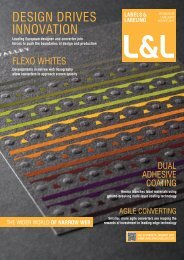THE DATA FRONT
Download as PDF - Labels & Labeling
Download as PDF - Labels & Labeling
- No tags were found...
You also want an ePaper? Increase the reach of your titles
YUMPU automatically turns print PDFs into web optimized ePapers that Google loves.
Labels&Labeling |47<br />
sleeves<br />
composite sleeve, this is a separate<br />
piece, but in a ribbed sleeve the cladding<br />
is integrated with the ribs. The ceramic is<br />
applied directly to the cladding.<br />
The best way to understand the<br />
differences between a composite and<br />
a ribbed sleeve is to understand how<br />
each supports the expansion foam. The<br />
composite sleeve can be compared to<br />
a concrete floor that fully supports the<br />
foam. The ribbed sleeve is like a floor<br />
supported by joists – the ribs support<br />
the foam, which limits the amount of<br />
foam doing the work of compressing<br />
and expanding. The ribbed sleeve<br />
has advantages in lighter weight and<br />
integrated end rings, but it also has<br />
drawbacks: fluid can find a home in<br />
the space between the ribs, and when<br />
mishandled, the ribs can bend like<br />
an accordion. On the other hand, the<br />
composite sleeve supports the foam<br />
better, but it also requires separate<br />
end rings to protect the foam from the<br />
printing environment. When properly<br />
handled, both types of sleeves will<br />
perform to the needs of the printer.<br />
Sleeve handling<br />
The differences in a sleeve’s construction<br />
introduce handling issues different from<br />
conventional anilox rollers. In most cases<br />
sleeves can be hand-carried, which is<br />
convenient but offers a greater chance<br />
that the ceramic surface can be bumped<br />
and sustain damage.<br />
Think of this in terms of carrying a oneor<br />
two-meter plank of wood through your<br />
house: The section of plank behind you<br />
crashes into walls and furniture more<br />
often than the part that you can see in<br />
front of you. The same is true with an<br />
anilox sleeve. The ends can be chipped<br />
very easily simply while loading and<br />
unloading a sleeve from the storage<br />
rack or press mandrel. The best solution<br />
to these bumps and chips is to make<br />
the pressroom damage-proof. Walk<br />
out into the pressroom and watch the<br />
staff as they handle the sleeves. Note<br />
everything that may come in contact<br />
with the sleeves, including hand rails,<br />
storage post stops, floor set-down areas,<br />
press cross frames, staging areas, wash<br />
sink edges, etc., and put foam padding<br />
on these areas. This simple measure<br />
can cost less than going out to dinner,<br />
but it will save thousands in anilox<br />
reconditioning costs.<br />
Sleeves are vulnerable to damage<br />
even after they are mounted on the<br />
mandrels. Check carefully for any item<br />
that may rub on the rotating sleeves.<br />
We receive sleeves that have 3 to 5 mm<br />
of the length removed from one end or<br />
from both ends as a result of chafing on<br />
sling guards, evaporative covers, ink drip<br />
pans, ink chambers, long doctor blades<br />
and other items. Sleeves are primarily<br />
made of aluminum and almost everything<br />
else around them is harder, so look<br />
for anything that can come in contact<br />
with your sleeves. And always use a<br />
ladder or lift when loading or unloading<br />
sleeves, so they move perpendicularly<br />
to the mandrel. Pushing or pulling them<br />
overhead causes damage.<br />
Cleanliness saves sleeves<br />
Because the anilox sleeve is completely<br />
dependent on the press mandrel for its<br />
rotation, the cleanliness of the mandrel<br />
is a significant factor in the sleeve’s<br />
TIR. Ink sticks to ink, and when given<br />
the opportunity to accumulate on the<br />
mandrels and in the sleeve bores, ink will<br />
glue a sleeve to its mandrel. In addition<br />
to the serious TIR problems this can<br />
cause, dirty mandrels also increase the<br />
likelihood of damage to the foam layer<br />
and to the structural integrity of the<br />
sleeve itself, because when a sleeve is<br />
stuck, we all know that the pressman is<br />
inclined to jiggle and rattle the sleeve in a<br />
manner similar to shaking coconuts out<br />
of a tree. In addition to real damage, dirty<br />
mandrels and bores simply cause costly<br />
nuisances like delays in loading and<br />
unloading. In other words, keep press<br />
mandrels and sleeve bores clean!<br />
It’s easy to remove ink from the sleeve<br />
bore by making a bore cleaner that<br />
looks like a canon ramrod or chimney<br />
sweep device. Air duct brushes are<br />
available in different diameters, or round<br />
Ran without end ring and end rubbing<br />
End wear with delamination of layers<br />
Advantages of anilox sleeves<br />
• Lower freight costs and lighter weight<br />
• Easier and safer to handle and are<br />
reprocessable<br />
• Reduce setup times for the printer: the<br />
process of changing out sleeves takes<br />
a fraction of the time it typically takes to<br />
change out conventional anilox rolls<br />
• Tooling costs are reduced because you<br />
do not need a separate set of gears and<br />
bearings for each anilox<br />
• Storage systems can be manufactured from<br />
lighter weight materials because they have<br />
to support less weight<br />
may 2009 | L&L


